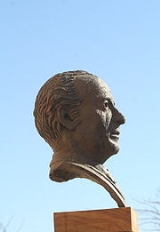
Antonio León Ortega
Encyclopedia
Antonio León Ortega, Ayamonte
(Huelva
), December 7, 1907 - Huelva
, January 9, 1991, Spanish
sculptor
, he had his professional education in Madrid and he created a personal style in the Andalusian imagery of the 20th century.
, in the county of Huelva
, on December 7, 1907.
When he was a teenager, he showed a restless passion and an innate ability for sculpture, producing his first self-taught works. When, years later, they were shown to the master Mariano Benlliure, they appeared to be typical of a mature sculptor.
He carried on his studies in Madrid from 1927 to 1934. He attended the Escuela de Bellas Artes de San Fernando, where he studied sculpture and design teaching under excellent teachers such as Mariano Benlliure
, José Capuz, Manuel Benedito and Juan Adsuara, with whom he worked during a stage of his production.
In those years he approached Castilian imagery: he studied it in Valladolid
, where he found his mentor in Gregorio Fernández
.
Since 1938 he worked in his first workshop in San Cristobal Street in Huelva, sharing it with the painter Pedro Gómez. Soon the workshop became not only an informal school of artists, but also an atheneum of arts and humanities, frequented by all the artists who lived or passed through Huelva such as poets, journalists, doctors and writers. The workshop was known in the artistic world as the “San Cristobal’s Academy”.
In the same years, he studied the Sevillana imagery through the works of the master Martínez Mountañés
.
In 1964 he moved to a new workshop in Medico Luís Buendía Street and he worked there until 1985, year in which illness moved him away from all the activities.
In these 50 years of hard work, he produced more than four hundred works, including small and great size works, made of different materials such as wood, mud, stone, brass, and others.
He elaborated on the religious works from a previous sketch drawn on mud and he sculpted them directly onto the wood with the help of the gouge and the mallet. In this way, he followed the traditional Spanish imagery way learned in Madrid from José Capuz and Juan Adsuara.
He produced lots of the images for the Holy Week of Huelva and Ayamonte and of many other towns in the counties of Huelva and Badajoz. He created other important religious and civil works in Seville, Cadiz, Malaga, Caceres, Salamanca, Pontevedra, Madrid, Belgium, United States, etc., as well as many others in smaller sizes, belonging to private collections in America and in Spain.
He created a modernist style of sculpture in Madrid, according to the twenties style: we can easily find it in works like the Retrato de Luna, in Manuel Bendito Museum, and the Retrato de Trinidad Navarro in Ayamonte.
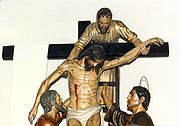 León Ortega is the author of one of the most serious, rigorous and personal sculptures in Spain in the 20th century, creating an easily distinguishable personal style.
León Ortega is the author of one of the most serious, rigorous and personal sculptures in Spain in the 20th century, creating an easily distinguishable personal style.
He got the best of his production in the sculptural groups, preferring the sculpture to the imagery, — The Descendimiento of Huelva, in which he combined the expressive force of Berruguete with the Andalusian sweetness of his style, — it represents a real masterpiece. In the Crucificados, —the Cristo de la Sangre de los Estudiantes is rich in such a unique elegance and beauty —.
He also produced many Madonnas with faces full of suppressed pain (he didn’t like the candlestick images, he preferred the full size). The Virgen del amor of Huelva represents its maximum example.
His outstanding productions include: the Yacente, the Cristo del Perdòn, the Angel de la oraciòn, the Cristo de la Borriquita, the Jesùs de las tres Caidas, the Cristo de la Victoria, the Cristo de la Conception, the San Cristobal, the Virgen de las Angustias and the Virgen de los Angeles in Huelva, the Pasión, the Yacente de las Angustias, the Cautivo, the Cristo de las Aguas and the Virgen de la paz in Ayamonte, the Nazareno of Beas
and the Nazareno of Moguer
.
At the same time he was an educator; he taught drawing and modelling classes in his workshop, in the Diocesan seminary and where today is the León Ortega School of Arts.
As sculptor, he mostly gave himself up to creating images, not only because this artistic field had always attracted him, but also because he was motivated by intimate religious convictions, that, connected to his social sensibility, place him into the area of the most involved Christianity.
His first religious works had a baroque touch, but then he found a very personal style: he chose a lighter form of lines and decorations and he tried to find a fusion between the Castillian and Andalucian imagery to get the essence of the sculpture only in its minimalism.
In the last five year period — he worked until he was eighty — his production lost part of its sculptorical power. He created only small size works because they needed just a little physical effort as, for example, his last masterpiece, the Busto de Madame Cazenave.
His images are characterized by strength, beauty and sweetness due to his passion for wooden sculpture and for the model.
León Ortega died on January 9, 1991 in his house in Huelva.
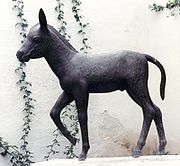
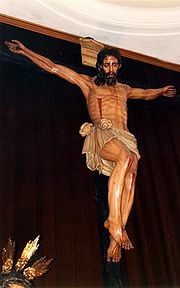
Almonaster la Real
Alosno
Aracena
Ayamonte
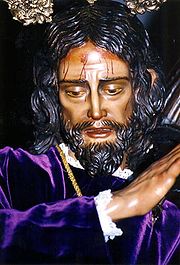
Beas
Cartaya
Corrales
Corteconcepción
El Campillo
El Cerro de Andévalo

El Judío
Galaroza
Gibraleón
Huelva
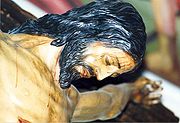
La Nava
La Redondela
 Lepe
Lepe
Lucena del Puerto
Mina la Zarza-Silos de Calañas
Minas de Riotinto
Minas de Tharsis
Moguer
Nerva
Niebla

Palos de la Frontera
Puebla de Guzmán
Sanlúcar de Guadiana
Santa Bárbara de Casa
Tharsis
Trigueros
Villablanca
Villanueva de los Castillejos
Villarrasa
----
Jerez de los Caballeros
Puebla de Sancho Pérez
----
----
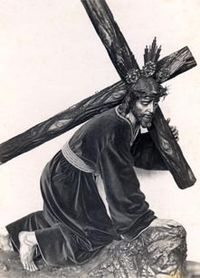 ----
----
La Fuente de San Esteban
Sancti Spiritus
Cristo, 1962, Parroquia.
----
La Puebla de Cazalla
Sevilla
Villanueva del Río y Minas
----
)
----
Ayamonte
Ayamonte is a town and municipality located in the province of Huelva, Spain. According to the 2005 census, the city has a population of 18,001 inhabitants.-Location and history:...
(Huelva
Huelva
Huelva is a city in southwestern Spain, the capital of the province of Huelva in the autonomous region of Andalusia. It is located along the Gulf of Cadiz coast, at the confluence of the Odiel and Tinto rivers. According to the 2010 census, the city has a population of 149,410 inhabitants. The...
), December 7, 1907 - Huelva
Huelva
Huelva is a city in southwestern Spain, the capital of the province of Huelva in the autonomous region of Andalusia. It is located along the Gulf of Cadiz coast, at the confluence of the Odiel and Tinto rivers. According to the 2010 census, the city has a population of 149,410 inhabitants. The...
, January 9, 1991, Spanish
Spain
Spain , officially the Kingdom of Spain languages]] under the European Charter for Regional or Minority Languages. In each of these, Spain's official name is as follows:;;;;;;), is a country and member state of the European Union located in southwestern Europe on the Iberian Peninsula...
sculptor
Sculpture
Sculpture is three-dimensional artwork created by shaping or combining hard materials—typically stone such as marble—or metal, glass, or wood. Softer materials can also be used, such as clay, textiles, plastics, polymers and softer metals...
, he had his professional education in Madrid and he created a personal style in the Andalusian imagery of the 20th century.
Biography
Antonio León Ortega was born in AyamonteAyamonte
Ayamonte is a town and municipality located in the province of Huelva, Spain. According to the 2005 census, the city has a population of 18,001 inhabitants.-Location and history:...
, in the county of Huelva
Huelva
Huelva is a city in southwestern Spain, the capital of the province of Huelva in the autonomous region of Andalusia. It is located along the Gulf of Cadiz coast, at the confluence of the Odiel and Tinto rivers. According to the 2010 census, the city has a population of 149,410 inhabitants. The...
, on December 7, 1907.
When he was a teenager, he showed a restless passion and an innate ability for sculpture, producing his first self-taught works. When, years later, they were shown to the master Mariano Benlliure, they appeared to be typical of a mature sculptor.
He carried on his studies in Madrid from 1927 to 1934. He attended the Escuela de Bellas Artes de San Fernando, where he studied sculpture and design teaching under excellent teachers such as Mariano Benlliure
Mariano Benlliure
Mariano Benlliure was a Spanish sculptor, who executed many public monuments and religious sculptures in Spain, working in a heroic realist style....
, José Capuz, Manuel Benedito and Juan Adsuara, with whom he worked during a stage of his production.
In those years he approached Castilian imagery: he studied it in Valladolid
National Sculpture Museum (Valladolid)
The National Museum of Sculpture is a museum in Valladolid, Spain, belonging to the Spanish Ministry of Culture. The museum has an extensive collection sculptural ranging from the Middle Ages to the nineteenth century from convents, donations, deposits and acquisitions of the state.The museum was...
, where he found his mentor in Gregorio Fernández
Gregorio Fernández
Gregorio Fernández was a Spanish Baroque sculptor. He belongs to the Castilian school of sculpture, following the style of other great artists like Alonso Berruguete, Juan de Juni, Pompeyo Leoni and Juan de Arfe.-Biography:...
.
Since 1938 he worked in his first workshop in San Cristobal Street in Huelva, sharing it with the painter Pedro Gómez. Soon the workshop became not only an informal school of artists, but also an atheneum of arts and humanities, frequented by all the artists who lived or passed through Huelva such as poets, journalists, doctors and writers. The workshop was known in the artistic world as the “San Cristobal’s Academy”.
In the same years, he studied the Sevillana imagery through the works of the master Martínez Mountañés
Juan Martínez Montañés
Juan Martínez Montañés , known as el Dios de la Madera , was a Spanish sculptor, born at Alcalá la Real, in the province of Jaén. He was one of the most important figures of the Sevillian school of sculpture.His master was Pablo de Roxas. His first known work, dating 1597, is the graceful St...
.
In 1964 he moved to a new workshop in Medico Luís Buendía Street and he worked there until 1985, year in which illness moved him away from all the activities.
In these 50 years of hard work, he produced more than four hundred works, including small and great size works, made of different materials such as wood, mud, stone, brass, and others.
He elaborated on the religious works from a previous sketch drawn on mud and he sculpted them directly onto the wood with the help of the gouge and the mallet. In this way, he followed the traditional Spanish imagery way learned in Madrid from José Capuz and Juan Adsuara.
He produced lots of the images for the Holy Week of Huelva and Ayamonte and of many other towns in the counties of Huelva and Badajoz. He created other important religious and civil works in Seville, Cadiz, Malaga, Caceres, Salamanca, Pontevedra, Madrid, Belgium, United States, etc., as well as many others in smaller sizes, belonging to private collections in America and in Spain.
He created a modernist style of sculpture in Madrid, according to the twenties style: we can easily find it in works like the Retrato de Luna, in Manuel Bendito Museum, and the Retrato de Trinidad Navarro in Ayamonte.

He got the best of his production in the sculptural groups, preferring the sculpture to the imagery, — The Descendimiento of Huelva, in which he combined the expressive force of Berruguete with the Andalusian sweetness of his style, — it represents a real masterpiece. In the Crucificados, —the Cristo de la Sangre de los Estudiantes is rich in such a unique elegance and beauty —.
He also produced many Madonnas with faces full of suppressed pain (he didn’t like the candlestick images, he preferred the full size). The Virgen del amor of Huelva represents its maximum example.
His outstanding productions include: the Yacente, the Cristo del Perdòn, the Angel de la oraciòn, the Cristo de la Borriquita, the Jesùs de las tres Caidas, the Cristo de la Victoria, the Cristo de la Conception, the San Cristobal, the Virgen de las Angustias and the Virgen de los Angeles in Huelva, the Pasión, the Yacente de las Angustias, the Cautivo, the Cristo de las Aguas and the Virgen de la paz in Ayamonte, the Nazareno of Beas
Beas, Spain
Beas is a municipality located in the province of Huelva, Spain. According to the 2005 census, the village has a population of 4,162 inhabitants.-Demographics:-External links:* - Sistema de Información Multiterritorial de Andalucía...
and the Nazareno of Moguer
Moguer
Moguer is a municipality and small city located in the province of Huelva, Andalusia, Spain. According to the 2007 census, it has a population of 18,381. Its surface area is , and its population density is ....
.
At the same time he was an educator; he taught drawing and modelling classes in his workshop, in the Diocesan seminary and where today is the León Ortega School of Arts.
As sculptor, he mostly gave himself up to creating images, not only because this artistic field had always attracted him, but also because he was motivated by intimate religious convictions, that, connected to his social sensibility, place him into the area of the most involved Christianity.
His first religious works had a baroque touch, but then he found a very personal style: he chose a lighter form of lines and decorations and he tried to find a fusion between the Castillian and Andalucian imagery to get the essence of the sculpture only in its minimalism.
In the last five year period — he worked until he was eighty — his production lost part of its sculptorical power. He created only small size works because they needed just a little physical effort as, for example, his last masterpiece, the Busto de Madame Cazenave.
His images are characterized by strength, beauty and sweetness due to his passion for wooden sculpture and for the model.
León Ortega died on January 9, 1991 in his house in Huelva.
Public Works
- Beato San José Ramírez, 1955, Ayamonte.
- Platero , 1963, House of ZenobiaZenobia CamprubíZenobia Camprubí Aymar was a Spanish-born writer and poet; she was also a noted translator of the works of Rabindranath Tagore....
. Museum Juan Ramón JiménezJuan Ramón JiménezJuan Ramón Jiménez Mantecón was a Spanish poet, a prolific writer who received the Nobel Prize in Literature in 1956. One of Jiménez's most important contributions to modern poetry was his advocacy of the French concept of "pure poetry."-Biography:Jiménez was born in Moguer, near Huelva, in...
. MoguerMoguerMoguer is a municipality and small city located in the province of Huelva, Andalusia, Spain. According to the 2007 census, it has a population of 18,381. Its surface area is , and its population density is ....
.

- Monument to the Bishop P. Cantero Cuadrado, 1964. Diocesan seminar, Huelva.
- Monument to the painter Pedro Gómez, 1965, The Conquero, Huelva.
- Monument to Alonso SánchezAlonso SánchezAlonso Sánchez was a fifteenth-century mariner and merchant born in Huelva, Spain, on Andalusia's Atlantic coast...
, 1970, Gardens Alonso Sánchez, Huelva. - Monuments to Brother Juan Pérez and to Brother Antonio of Marchena, 1970, La Rabida Monastery, Environment of the monastery, Palos de la Frontera.
- Virgin Monumento of the Cinta, 1977, Hdad. de la Cinta, Sanctuary of Ntra. Sra. de la Cinta, Gardens, Huelva.
- Monumento to Martin Alonso Pinzón, 1978, Baiona. Pontevedra.
- Imágenes of the Facade of the Cathedral of the Merced: Virgin of the Grace , San Leandro , San Walabonso , San VicenteVincent of SaragossaSaint Vincent of Saragossa, also known as Vincent Martyr, Vincent of Huesca or Vincent the Deacon, is the patron saint of Lisbon. His feast day is 22 January in the Roman Catholic Church and Anglican Communion and 11 November in the Eastern Orthodox Churches...
and Santa MaríaBlessed Virgin Mary (Roman Catholic)Roman Catholic veneration of the Blessed Virgin Mary is based on Holy Scripture: In the fullness of time, God sent his son, born of a virgin. The mystery of the incarnation of the Son of God through Mary thus signifies her honour as Mother of God...
, 1978, Cathedral of the Merced, HuelvaHuelvaHuelva is a city in southwestern Spain, the capital of the province of Huelva in the autonomous region of Andalusia. It is located along the Gulf of Cadiz coast, at the confluence of the Odiel and Tinto rivers. According to the 2010 census, the city has a population of 149,410 inhabitants. The...
. (picture) - Monumento to Sor Ángela of the Cruz, 1984, Square of Isabel the Catholic (Square Niña), Huelva.
- Monumento to Madame Cazenave , 1985, Square of Madame Cazenave, Huelva.
Huelva
AljaraqueAljaraque
Aljaraque is a city located in the province of Huelva, Spain. According to the 2005 census, the city has a population of 14,846 inhabitants.-Demographics:- Main sights :* Church of Nuestra Señora de Los Remedios...
- Nazareno , 1940, Parroquia .
- San Sebastián, 1944, Parroquia .

- Ntra. de los Remedios, 1951, Parroquia de Ntra. de los Remedios.
- Virgen de los Milagros, 1980, Church of Bellavista.
Almonaster la Real
Almonaster la Real
Almonaster la Real is a town and municipality located in the province of Huelva, Spain. According to the 2005 census, the city had a population of 1,805 inhabitants.-Demographics:-Mezquita, 10th Century:...
- Cristo del Amor, 1948, Parroquia de San Martín.
- Cristo , 1961, City council, Capilla del Cementerio.
Alosno
Alosno
Alosno is a town and municipality located in the province of Huelva, Spain. According to the 2005 census, the city has a population of 4,514 inhabitants.The noted Spanish boxer Pedro Carrasco, and the fandango singer Paco Toronjo were born in Alosno....
- Cristo atado a la columna, 1944, Capilla .
- Evangelistas , 1944, Parroquia .
Aracena
Aracena
Aracena is a town and municipality located in the province of Huelva, south-western Spain. , the city has a population of 7,612 inhabitants.-Main sights:...
- Cristo de la Sangre atado, 1943, Hermandad de la Vera-Cruz, Iglesia Prioral del Castillo.
- San Antonio Abad, 1943, Madres Carmelitas, Iglesia de Sta. Catalina.
- Sayones (two) , 1945, Fraternity of the See-Cruz, Iglesia Prioral del Castillo.
- Virgen del Carmen, 1967, Madres Carmelitas, Iglesia de Sta. Catalina.
Ayamonte
Ayamonte
Ayamonte is a town and municipality located in the province of Huelva, Spain. According to the 2005 census, the city has a population of 18,001 inhabitants.-Location and history:...
- Retrato de Andrea Valdés, 1928, Private.
- Retrato de Miguel Valdés, 1928, Private.
- Retrato de Alberto Vélez and Mrs. ., 1931, Private.
- Retrato de Trinidad Navarro, 1931, Private.

- Venus desnuda, 1931, Private.
- Retrato de Margarita Moreno, 1932, Privado.
- San Francisco, 1937, Hnas. de la Cruz. Convento Hermanas de la Cruz.
- Cristo Yacente, 1938, Hdad. de la Vera-Cruz, Iglesia de San Francisco.
- Cristo de la Vera-Cruz, 1940, Hdad. de la Vera-Cruz, Iglesia de San Francisco.
- Jesús de la Pasión, 1941, Hdad. de Pasión, Iglesia de las Angustias.
- Virgen de la Paz, 1944, Hdad. de Pasión, Iglesia de las Angustias.
- Cristo yacente, 1946, Hdad. del Santo Entierro, Iglesia de las Angustias.
- San Antonio, 1950, Iglesia de las Angustias.
- Cristo de las Aguas, 1957, Hdad. de la Lanzada, Iglesia de San Francisco.
- Jesús orando y Ángel, 1968, Hdad. de la Oración en el Huerto, Iglesia de El Salvador
- Virgen del Buen Fin, 1970, Hdad. de la Lanzada, Iglesia de San Francisco.
- Virgen del Rosario, 1972, Hdad. de Jesús Cautivo, Iglesia de la Merced.
- Cautivo, 1973, Hdad. de Jesús Cautivo, Iglesia de la Merced.
- Caballo, 1973, Hdad. de la Lanzada, Iglesia de San Francisco.
- Longinos, 1973, Hdad. de la Lanzada, Iglesia de San Francisco.
- Sor Ángela de la Cruz, 1984, Iglesia de las Angustias.
Beas
- Jesús de la Amargura, Nazareno, 1943, Hdad. del Nazareno, Ermita Virgen de los Clarines.
- Simón Cirineo, 1943, Hdad. del Nazareno, Ermita Virgen de los Clarines.
- Jesús Cautivo, 1947, Capilla del Sagrario.
- Resucitado, 1967, Parroquia.
Cartaya
Cartaya
Cartaya is a spanish locality and municipality in the province of Huelva . In 2010 had 18,415 inhabitants. Its surface area is 226.4 km² and has a density of 81.34 people per km²....
- Virgen del Rosario, 1939, Parroquia de San Pedro Apóstol.
- San Sebastián, 1942, Ayuntamiento, Parroquia.
- Virgen de la Amargura, 1951, Hdad. de la Vera Cruz, Parroquia de San Pedro.
- Stmo. Cristo de la Vera Cruz, 1954, Hdad. de la Vera Cruz, Iglesia Parroquial de San Pedro.
- Virgen de las Mercedes, 1967.
Corrales
- Santa Bárbara, 1958, Parroquia.
- Santa María Reina del Mundo, 1958, Parroquia.
- Cautivo, 1959, Parroquia.
Corteconcepción
Corteconcepción
Corteconcepción is a town and municipality located in the province of Huelva, Spain. According to the 2005 census, it has a population of 620 inhabitants and covers a 49km² area. It sits at an altitude of 572m above sea level, and is 114km from the capital.-External links:* - Sistema de Información...
- Virgen de los Dolores, 1958, Parroquia.
El Campillo
- Crucificado, 1967, Iglesia parroquial.
El Cerro de Andévalo
El Cerro de Andévalo
El Cerro de Andévalo is a town and municipality located in the province of Huelva, Spain. According to the 2005 census, the municipality has a population of 2,636 inhabitants.-External links:...
- Calvario en el Retablo, 1953, Parroquia de Ntra. Sra. de Gracia.
- Virgen del Andévalo, 1953, Parroquia Ntra. Sra. de Gracia.

- Virgen de Albricias, 1958, Parroquia de Ntra. Sra. de Gracia.
- Nazareno, 1969, Hermandad Sacramental, Parroquia de Ntra. Sra. de Gracia.
- Sor Ángela de la Cruz, 1984, Plaza Sor Ángela.
El Judío
- Virgen del Perpetuo Socorro, 1968, Capilla de Ntra. Sra. del Perpetuo Socorro.
- Cristo, 1978, Iglesia, Capilla de Ntra. Sra. del Perpetuo Socorro.
Galaroza
Galaroza
Galaroza is a town and municipality located in the province of Huelva, Spain. According to the 2005 census, the city has a population of 1,642 inhabitants.-External links:* - Sistema de Información Multiterritorial de Andalucía...
- Cristo del Murtiga, 1951, Iglesia Ntra. Sra. del Carmen.
Gibraleón
Gibraleón
Gibraleón is a town and municipality located in the province of Huelva, Spain. According to the 2005 census, the municipality has a population of 11,202 inhabitants.-External links:* - Sistema de Información Multiterritorial de Andalucía...
- Virgen de la Soledad, 1947, Capilla Ntra. Sra. del Carmen.
Huelva
Huelva
Huelva is a city in southwestern Spain, the capital of the province of Huelva in the autonomous region of Andalusia. It is located along the Gulf of Cadiz coast, at the confluence of the Odiel and Tinto rivers. According to the 2010 census, the city has a population of 149,410 inhabitants. The...
- Primeras Obras del Campo: Perra Dora, Autorretrato, Pastor con vaca, Cabra 1, Cabra 2, Busto de Virgen, Cabeza Caballo, 1924, Foundation Escultor León Ortega.
- Virgen de la Victoria, 1940, Hdad. de la Victoria, unknown whereabouts.
- Jesús de la Humildad, Herodes y Sayones, 1942, Hdad. de la Victoria, Iglesia del Sagrado Corazón.
- Ntra., Sra. de la Paz, 1943, Hdad. del Stmo. Cristo de la Victoria, Iglesia de San Sebastián.
- Ángel, Oración en el Huerto, 1943, Hermandad Oración en el Huerto, Iglesia de la Concepción.
- Cristo Yacente, 1943, Hdad. de Ntra. Sra. de las Angustias, Ermita de la Soledad.
- Virgen de la Soledad, 1944, Hdad. de la Soledad, Ermita de la Soledad.
- Verónica, 1945, Hdad. de las Tres Caídas, Iglesia del Sagrado Corazón.
- Ntro. P. Jesús de las Penas en sus Tres Caídas, 1945, Hdad. de las Tres Caídas, Iglesia del Sagrado Corazón.
- Cristo de la Victoria y 3 Sayones, 1945, Hdad. del Stmo. Cristo de la Victoria, Iglesia de San Sebastián.
- Cristo del Perdón, 1946, Parroquia, Iglesia del Sagrado Corazón.
- Cristo en su Entrada Triunfal, 1946, Hdad. de la Entrada Triunfal "de la Borriquita", Iglesia de San Pedro.
- Niño con Palma, 1946, Hdad. de la Entrada Triunfal "de la Borriquita", Iglesia de San Pedro.
- Cristo del Amor, 1949, Hdad. Santa Cena, Iglesia del Sagrado Corazón.
- Virgen de los Ángeles, 1949, Hdad. de la Entrada Triunfal "de la Borriquita", Iglesia de San Pedro.
- María Stma. del Amor, 1949, Hdad. de las Tres Caídas, Iglesia del Sagrado Corazón.
- Cristo de la Sangre, 1950, Hermandad de los Estudiantes, Iglesia de San Sebastián.

- San Juan Evangelista, 1951, Hdad. de la Victoria, Iglesia del Sagrado Corazón.
- Virgen de la Resignación en sus Dolores, 1952, Hdad. del Descendimiento, Iglesia de San Pedro.
- Grupo del Descendimiento: Cristo, Virgen, Magdalena, San Juan, José de Arimatea y Nicodemo, 1952–1953, Hdad. del Descendimiento, Iglesia de San Pedro.
- Ntra. Sra. del Rosario, 1954, Hdad. Sagrada Cena, Iglesia del Sagrado Corazón.
- Virgen del Valle, 1956, Hermandad de los Estudiantes, Iglesia de San Sebastián.
- Ntra. Sra. de Montemayor, 1956, Ilustre Hdad. Filial de Ntra. Sra. de Montemayor, Iglesia del Sagrado Corazón, Capilla Hermandad Tres Caídas.
- San Cristóbal, 1956, Iglesia de los Dolores.
- Virgen del Rocío, 1958, Parroquia, Iglesia de Nuestra Señora del Rocío.
- Virgen de las Angustias, 1958, Hdad. de Ntra. Sra. de las Angustias, Ermita de la Soledad.
- San Juan de Dios, 1959, Obispado, Catedral de la Merced.
- Virgen de Gracia, 1960, Seminario, Capilla del Seminario Menor.
- Relieve Virgen del Rocío, 1961, Hdad. de las Tres Caídas, Casa Hermandad Tres Caídas.
- Virgen de la Amargura, 1967, Hermanas de la Cruz, Convento de las Hermanas de la Cruz.
- Cristo, 1967, Capilla Escuela Náutica Pesquera.
- Corazón de Jesús, 1967, Parroquia, Iglesia de San Pedro.
- Virgen de los Milagros, 1967, Diputación de Huelva.
- Beato Mtro. Juan de Ávila, 1967, Seminario Diocesano.
- Cristo de la Iglesia de la Concepción, 1968, Ermita de la Soledad.
- Cristo, 1968, Hospital, Capilla Hospital Vázquez Díaz.
- Virgen del Carmen, 1968, Hospital, Capilla Hospital Vázquez Díaz.
- Cristo, 1972, Hermanas de la Cruz, Convento de las Hermanas de la Cruz.
- Corazón de Jesús, 1972, Hermanas de la Cruz, Convento de las Hermanas de la Cruz.
- Santa María Madre de la Iglesia, 1973, Parroquia, Iglesia de Santa María Madre de la Iglesia.
- Jesús del Calvario, 1973, Hdad. del Calvario, Capilla de Jesús del Calvario.
- Jesús Cautivo, 1974, Parroquia del Rocío, Iglesia de Nuestra Señora del Rocío.
- Cristo de la Fe, 1975, Hdad. de la Fe, Iglesia de Santa María Madre de la Iglesia.
- Cristo, 1975, Hnas. Nazarenas, Capilla Hermanas Misioneras de Nazaret.
- Virgen con Niño (Stma. Virgen de Nazaret), 1975, Hnas Nazarenas, Capilla Hermanas Misioneras de Nazaret.
- Cristo Crucificado, 1975, Parroquia, Iglesia de Nuestra Señora del Rocío.
- Cristo Crucificado, 1979, Parroquia, Iglesia Parroquial de San Juan de Ávila.
- Virgen del Amparo, 1983, Residencia de Pensionistas La Orden.
- Cirineo, 1983, Hdad. del Cristo de la Flagelación, Iglesia del Gran Poder.
- Jesús Cautivo, 1985, Hermandad del Cautivo, Capilla de la Misericordia.
- Busto M. Cazenave, 1985, Foundation Escultor León Ortega.
La Nava
La Nava
La Nava is a town and municipality located in the province of Huelva, Spain. According to the 2008 census, the municipality had a population of 330 inhabitants....
- Cristo de los Caminantes o las Virtudes, 1967, Ermita del Cristo de las Virtudes.
La Redondela
- Nazareno, 1941, Iglesia Parroquial.

Lepe
Lepe is a Spanish town in the province of Huelva, in the autonomous community of Andalusia. It is situated near the Portuguese border. According to the 2009 census, the city has a population of 25,886 inhabitants.-Economy:...
- San Francisco Javier, 1954, Parroquia, Parroquia de Sto. Domingo.
- Virgen del Carmen, 1954, Parroquia, Capilla del Carmen.
- Virgen de la Paz, 1966, Hdad. de la Borriquita, Capilla del Cristo del Mar.
- Cautivo, 1980, Capilla del Cristo del Mar.
- Grupo de la Borriquita, 1980, Capilla del Cristo del Mar.
- Cristo, 1969, Parroquia de Ntra. Sra. del Carmen. La Antilla.
- Virgen del Carmen, 1969, Parroquia de Ntra. Sra. del Carmen. La Antilla.
Lucena del Puerto
Lucena del Puerto
Lucena del Puerto is a town and municipality located in the province of Huelva, Spain. According to the 2005 census, it has a population of 2,283 inhabitants.-External links:* - Sistema de Información Multiterritorial de Andalucía...
- Virgen del Rocío, 1942, Hdad. del Rocío, Parroquia de San Vicente Mártir.
- Virgen de Consolación en sus Dolores, 1948, Hdad. del Señor del Gran Poder y Ntra. Sra. de Consolación, Parroquia de San Vicente Mártir.
- Jesús del Gran Poder, 1948, Hdad. del Señor del Gran Poder y Ntra. Sra. de Consolación, Parroquia de San Vicente Mártir.
- Virgen de la Luz, 1956, Hacienda de la Luz, Oratorio.
Mina la Zarza-Silos de Calañas
- Cristo del Perdón, 1947, Parroquia de Santa Bárbara.
- Santa _Bárbara, 1950, Congregación Mariana, Parroquia de Santa Bárbara.
- Virgen de la Amargura, 1956, Parroquia de Santa Bárbara.
- San Agustín (Retablo), 1956, Parroquia de Santa Bárbara.
- San Francisco Javier, 1956, Parroquia de Santa Bárbara.
Minas de Riotinto
Minas de Riotinto
Minas de Ríotinto is a town and municipality located in the province of Huelva, southern Spain.-External links:* - Sistema de Información Multiterritorial de Andalucía* - Riotinto's website...
- Cristo, 1947, Parroquia de Santa Bárbara.
- Inmaculada, 1951, Parroquia de Santa Bárbara.
Minas de Tharsis
- Dolorosa, 1967.
Moguer
Moguer
Moguer is a municipality and small city located in the province of Huelva, Andalusia, Spain. According to the 2007 census, it has a population of 18,381. Its surface area is , and its population density is ....
- Jesús Nazareno, 1938, Hdad. Ntro. Padre Jesús Nazareno, Ermita de San Sebastián.
- San Juan Evangelista, 1940, Hdad. del Nazareno, Ermita de San Sebastián.
- Virgen de los Dolores ó Ntra. Sra. de Engracia, 1944, Hdad. Ntro. Padre Jesús Nazareno, Ermita de San Sebastián.
- Cirineo, 1947, Hdad. Ntro. Padre Jesús Nazareno, Ermita de San Sebastián.
- Cristo de la Paz Eterna, (yacente), 1962, Cofradía de Nazarenos de Stimo. Cristo de la Misericordia, Ermita de San Sebastián.
- San Francisco de Asís, 1963, Iglesia de San Francisco.
- Cristo del Amor y Ángel de la Oración en el Huerto, 1975, Cofradía de Jóvenes Nazarenos de Stimo. Cristo del Amor en la Oración en el Huerto, Ermita de San Sebastián.
Nerva
- Virgen Dolorosa, 1967, Parroquia.
Niebla

- Inmaculada, 1963, Parroquia de Ntra. Sra. de la Granada.
- San Bernabé, 1967.
Palos de la Frontera
Palos de la Frontera
Palos de la Frontera is a town and municipality located in the southwestern Spanish province of Huelva, in the autonomous community of Andalusia. It is situated some from the provincial capital, Huelva...
- Cristo del Mayor Dolor, (crucificado), 1962, La Rabida MonasteryLa Rabida MonasteryLa Rábida Monastery is a Franciscan monastery in the southern Spanish town of Palos de la Frontera, in the province of Huelva and the autonomous region of Andalucia...
. - Santa María de la Rábida, Virgen de los Milagros, versión de León de la original del siglo XIV, 1966, La Rabida MonasteryLa Rabida MonasteryLa Rábida Monastery is a Franciscan monastery in the southern Spanish town of Palos de la Frontera, in the province of Huelva and the autonomous region of Andalucia...
. - San Jorge, 1976, Parroquia de San Jorge Mártir.
Puebla de Guzmán
Puebla de Guzmán
Puebla de Guzmán is a town and municipality located in the province of Huelva, Spain. According to the 2005 census, it has a population of 3,109 inhabitants.-External links:* - Sistema de Información Multiterritorial de Andalucía...
- Santa Lucía, 1953, Parroquia Sta. Cruz Nazareno.
- Nazareno, 1967, Parroquia Sta. Cruz Nazareno.
Sanlúcar de Guadiana
Sanlúcar de Guadiana
Sanlúcar de Guadiana is a localidad in the province of Huelva, Andalusia, Spain, situated 55 km from the city of Huelva. The inhabitants are known as Sanluqueños...
- Virgen de la Rábida, 1938, Parroquia de Ntra. Sra. de las Flores.
Santa Bárbara de Casa
Santa Bárbara de Casa
Santa Bárbara de Casa is a town in Spain, in the county of Huelva. It lies 80 km from Huelva.-History:It was reconquered from the Moors by Alfonso X, and passed to the noble family of Guzmán. The area was surveyed on December 5, 1550, and the town was called Santa Barvola. In 1643, the town...
- Santa Bárbara, 1967.
Tharsis
- Cristo, 1958, Parroquia de Santa Bárbara.
- Inmaculada, 1958, Parroquia de Santa Bárbara.
Trigueros
Trigueros, Spain
Trigueros is a town and municipality located in the province of Huelva, Spain. According to the 2008 census, the municipality had a population of 7477 inhabitants....
- San Antonio Abad, 1979, Hdad. del Rocío de Trigueros, Capilla Hdad. del Rocío.
Villablanca
Villablanca
Villablanca is a town and municipality located in the province of Huelva, Spain. According to the 2009 census, the municipality had a population of 2793 inhabitants....
- Cristo del Amor, 1977, Parroquia de San Sebastián.
Villanueva de los Castillejos
Villanueva de los Castillejos
Villanueva de los Castillejos is a town and municipality located in the province of Huelva, Spain. According to the 2008 census, the municipality had a population of 2783 inhabitants....
- Inmaculada, 1950, Iglesia de la Inmaculada Concepción.
Villarrasa
Villarrasa
Villarrasa is a town and municipality located in the province of Huelva, Spain. According to the 2005 census, it has a population of 2095 inhabitants and covers a 72km² area. It sits at an altitude of 65m above sea level, and is 37km from the capital.-External links:* - Sistema de Información...
- San Isidro 1967.
----
Badajoz
Bodonal de la SierraBodonal de la Sierra
Bodonal de la Sierra is a municipality located in the province of Badajoz, Extremadura, Spain....
- Cristo de las Siete Palabras, 1971, Parroquia de San Blas.
Jerez de los Caballeros
Jerez de los Caballeros
Jerez de los Caballeros is a town of south-western Spain, in the province of Badajoz. It is situated on two heights overlooking the River Ardila, a tributary of the Guadiana, 12 miles east of the Portuguese frontier. The old town is surrounded by a Moorish wall with six gates. The newer portion is...
- Cristo y Ángel en la Oración en el Huerto, 1956, Cofradía del Señor orando y Ntra. Sra. del Rosario, Iglesia Parroquial de San Miguel Arcángel.
- Grupo del Descendimiento: Cristo, Virgen, San Juan’’, José de Arimatea y Nicodemo, 1957, Cofradía de Ntro. Padre Jesús Nazareno, Iglesia de Santa María. *Virgen de la Encarnación, 1966, Cofradía de Ntro. Padre Jesús Nazareno, Iglesia de Santa María de la Encarnación.
- Corazón de Jesús, 1967, Torre del Reloj. Destroyed.
- Cristo Crucificado, 1969, Hermanas de la Cruz, Convento Hermanas de la Cruz.
- Virgen de la Salud, 1970, Hermanas de la Cruz, Convento Hermanas de la Cruz.
Puebla de Sancho Pérez
Puebla de Sancho Pérez
Puebla de Sancho Pérez is a municipality in the province of Badajoz, Extremadura, Spain. It has a population of 2,880 and an area of 57 km²....
- Cristo atado a la columna (Jesús Yacente), 1966, Hdad. de Ntro. Padre Jesús Nazareno, Parroquia.
- María Stima. del Mayor Dolor, 1968, Hdad. de Ntro. Padre Jesús Nazareno, Parroquia.
- Jesús orando en el huerto, 1971, Hdad. de la Oración en el Huerto, Parroquia.
----
Cáceres
- Cristo, 1955, Misioneros de la Preciosa Sangre de Cristo, Casa del Sol.
----
Madrid
- Retrato de Luna, 1930, Museo Estudio de Manuel Benedito.
- Virgen del Aire, 1967, Parroquia de Cuatro Vientos.
- Cristo, 1967, Parroquia de Cuatro Vientos.

Salamanca
Ciudad RodrigoCiudad Rodrigo
Ciudad Rodrigo is a small cathedral city in the province of Salamanca, in western Spain, with a population of about 14,000. It is the seat of a judicial district as well....
- San José, 1962, Seminario Diocesano, Seminario (Iglesia, Altar Lateral).
- Corazón de Jesús, 1962, Obispado de Ciudad Rodrigo, Parroquia del Sagrario.
La Fuente de San Esteban
La Fuente de San Esteban
La Fuente de San Esteban is a village and large municipality in the province of Salamanca, western Spain, part of the autonomous community of Castile-Leon...
- San Esteban, 1961, Parroquia (Retablo Central).
- Corazón de Jesús, 1963, Parroquia (Retablo Central).
- Corazón de María, 1963, Parroquia (Retablo Central).
Sancti Spiritus
Sancti Spíritus
Sancti Spíritus is a municipality and capital city of the province of Sancti Spíritus in central Cuba. Sancti Spíritus, Latin for "Holy Spirit," is one of the best preserved cities in the Caribbean from the time of the sugar trade.-History:...
Cristo, 1962, Parroquia.
----
Sevilla
La Puebla de Cazalla
La Puebla de Cazalla
La Puebla de Cazalla is a city located in the province of Seville, Spain. According to the 2005 census , the city has a population of 10,729 inhabitants.-External links:* - Sistema de Información Multiterritorial de Andalucía...
- Virgen de las Virtudes, 1953, Parroquia.
Sevilla
- Retrato de José Vázquez, 1936, Estudio de José Vázquez.
- Cristo, 1967, Hermanas de la Cruz, Casa Convento de la Beata Ángela de la Cruz.
Villanueva del Río y Minas
Villanueva del Río y Minas
Villanueva del Río y Minas is a city located in the province of Seville, Spain. According to the 2005 census , the city has a population of 5,237 inhabitants.-External links:* - Sistema de Información Multiterritorial de Andalucía...
- Virgen de la Salud, 1967, Hnas. de la Cruz, Capilla Hnas. de la Cruz.
----
USA
Stamford (ConnecticutConnecticut
Connecticut is a state in the New England region of the northeastern United States. It is bordered by Rhode Island to the east, Massachusetts to the north, and the state of New York to the west and the south .Connecticut is named for the Connecticut River, the major U.S. river that approximately...
)
- San Maximiliano, 1978, Holy Name Church.
----
Sources and Bibliography
- 2. González Gómez, Juan Miguel & Carrasco Terriza, Manuel Jesús, Escultura Mariana Onubense,1981, Instituto de Estudios Onubenses "Padre Marchena" & Diputación de Huelva, ISBN 84-85268-87-3.
- 3. Gil Vázquez, E., Padilla Pons, J., y Román Pantrigo, R., De la Historia de las Cofradías de Huelva, 1982, Delegación Cultura Huelva & Diputación de Huelva & Caja Provincial Ahorros Huelva.
- 4. Carrasco Terriza, Manuel Jesús, Andalucia y América en el siglo XX: Una escultura de León Ortega en Stamford, USA, pags. 269-274, 1986, Universidad de Sta. Maria de la Rábida, ISBN 84-00-06794-0.
- 5. Sugrañes Gómez, Eduardo J., Historia de la Semana Santa de Huelva, 1992, C.E.C.A., ISBN 84-606-0719-4.
- 6. Velasco Nevado, Jesús, Historia de la Pintura Contemporánea en Huelva: 1.892 - 1.992, 1993, Diputación de Huelva - Fundación El Monte, ISBN 84-86842-77-8.
- 7. AA. VV, A. León Ortega (1907–1991) Catálogo de la Exposición. Museo Provincial de Huelva, Abril-Mayo 1996. Huelva, Fundación El Monte-Junta de Andalucía, Consejería de Cultura, 1996, s.p.
- 8. Fernández Jurado, Jesús & García de la Concha Delgado, Federico & Rodríguez Mateos, Joaquín, Huelva Cofrade. Historia de la Semana Santa de Huelva y su Provincia. 4 tomos., 1997, Ediciones Tartessos, S.L. ISBN 84-7663-036-0
- 9. Carrasco Terriza, Manuel Jesús, La escultura del Crucificado en la tierra llana de Huelva, 2000, Diputación de Huelva, ISBN 84-8163-217-1.
- 10. de la Lastra Buades, Pedro Jesús & Cruzado García, Agustín, Semana Santa en Huelva, 2003, Marsay Ediciones, S. L., ISBN 84-85539-60-8.
- 11. AA. VV., El Pregón. Semana Santa en Ayamonte, 2003, Hermandad de El Salvador y Otras.
- 12. Garrido Palacios, Manuel, Una mirada a Huelva, 2004, Fundación Caja Rural del Sur, ISBN 84-609-2309-6.
- 13. de la Lastra Buades, Pedro Jesús, Tesoros de la Semana Santa de Huelva, 2004, El Correo de Andalucía, S.L.
- 14. Carrasco Terriza, M.J. & González Gómez, J.M. & Oliver Carlos, A. & Pleguezuelo Hernández, A. & Sánchez Sánchez, J.M., Guía artística de Huelva y su Provincia, 2006, Fundación José Manuel Lara ISBN 84-96556-19-0 & Diputación de Huelva ISBN 84-8163-295-X.
- 15. Diccionario Biográfico Español, Real Academia de la HistoriaReal Academia de la HistoriaReal Academia de la Historia is a Spanish institution based in Madrid that studies history "ancient and modern, political, civil, ecclesiastical, military, scientific, of letters and arts, that is to say, the different branches of life, of civilisation, and of the culture of the Spanish...
, Madrid, 2011.
External links
- Diccionario Biográfico Español, Real Academia de la Historia.
- School of Huelva Art León Ortega
- Page of Terriza Carrasco, Manuel Jesus, Doctor in History of the Art.
- Holy Week of Huelva.
- Holy Week of Ayamonte.
- Brotherhoods of Andalusia, The Hornacina
- Monument to Platero. Museum Juan Ramón Jiménez.
- Monument to Martin Alonso Pinzón. Baiona. Pontevedra.
- Holy Week of Sherry of the Gentlemen

